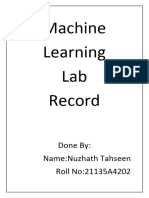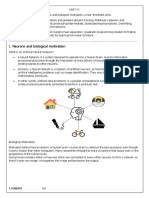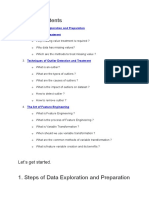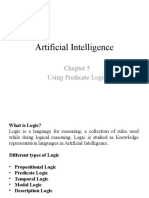Machine Learning Notes
Uploaded by
Nikhita NairMachine Learning Notes
Uploaded by
Nikhita Nair📈
Machine Learning Notes
Machine Learning Lifecyle:
1. Problem Definition: Defining the project requirements and business requirements.
Defining data requirements and modules.
2. Data Selection: Collect and prepare all of the relevant data for from dataset used in
machine learning.
3. Descriptive Statistics: Descriptive statistics are used to describe or summarize the
characteristics of a sample or data set.
4. Exploratory Data Analysis: Analysis of data. Find hidden patterns in the dataset.
5. Data Preprocessing: Data Cleaning, Imputing(Removing missing data) and getting
more useful and relevant data.
6. Data Transformation: Transforming the relevant data into appropriate form.
encoding techniques used(one hot), scaling, e.t.c.
7. Feature Selection: Selection of useful and informative features(attributes) and
eliminating irrelevant feature, optimizing the features. Required features to be used.
Filtering out best features. Subset of data selection.
Machine Learning Notes 1
8. Model Selection: Selection of model based on the variables. Selecting right
algorithm.
9. Model Training: 80-20 rule(training-80,test data-20),working on getting max
accuracy in training stage.
10. Model Evaluation: Model evaluation aims to estimate the generalization accuracy
of a model on future (unseen/out-of-sample) data.
11. Model Deployment: The process of taking a trained ML model and making its
predictions available to users or other systems is known as deployment.
Basic Terminologies:
Feature matrix/Data Matrix:
Matrix of all features
Features/Attributes:
Columns in a dataset
N-dimensional array/Data points:
Rows in a dataset
Dataset:
Set of data used for training model
Dependent/Output(y-axis) variable:
Variable which is output or predicted in a training model
Independent/Input(x-axis)variable:
Variable which is used for input in a training model
Target:
used for predicting
Types of Data:
Continuous variables- Always numeric, continuous and infinite, eg: height, score
Machine Learning Notes 2
Discrete variables- Numeric or categorical, countable and finite, eg: number of
fruits, gender,pincode,etc.
VLOOKUP() in Excel:
VLOOKUP()-merging various tables together, fetching data from multiple tables.
VLOOKUP(search criterion ;array; index; sort)
eg: VLOOKUP(State_ID; userState.A2-An; sort(asc/desc))
Types of Data Analysis:
UNIVARIATE ANALYSIS:
only using one feature
BIVARIATE ANALYSIS:
numeric vs numeric
categoric vs categoric
numeric vs categoric
MULTIVARIATE ANALYSIS:
using multiple features for doing analysis
~min()- it will return the minimum data from a particular dataset
Outlier is any data which is out of the range of your dataset. Anything below or above
the limits will be a outlier.
Upper limit=Q3+1.5IQR
Lower limit=Q1-1.5IQR
avg() used for calculation of mean
median() for calculating of
Coefficient of dispersion based on range: (max-min)/(max+min)
Coefficient of dispersion based on mean deviation: mean deviation/mean
Coefficient of dispersion based on range: (Q3-Q1)/(Q3+Q1)
Machine Learning Notes 3
Quartiles are divided in 4 parts:
Q2=median
Q1=25%, Q2=50%, Q3=75%, Q4=100%
QUARTILE()
IQR(INTER QUARTILE DEVIATION)
Q3-Q1=IQR
QUARTILE DEVIATION=IQR/2
Frequency table
-Divide in form particular ranges
-Frequency(data,classes)
-returns arrays
Pivot table for univariate categorical
pie chart used for 100% data
Bivariate Numeric vs Numeric
Correlation is the how two variables are re
Corelation range 1 to -1
1=two variable highly correlated
-1=highly negatively correlated(inversely)
0=no correlation
R-square is the square of correlation
Trendline is line of best fit
f(x) is the line equation (y=mx+c) in graph
Bivariate categorical vs categorical
Eg gender and state
Machine Learning Notes 4
Bivariate numeric vs categorical
eg: weight and gender
Multivariate: analysis on multiple variables
eg: each state and each gender their average height ,weight
CONCATENATE(col1;" ";col2;...;coln)-concatenating columns like names having more
than 1 word
removing inconsistencies from tables: PROPER(TRIM)-making it proper case and
removing spaces
UPPER()-uppercase and LOWER()- lowercase
combine TRIM with other function for removing extra spaces
Removing duplicates: using advanced filters > no duplication check
Imputation: filling out missing data; using average of a column/median/mode of the data;
if there is col where 70 to 80% NA,then you fill in data, dont use for model
Outliers: Anything below or above the lower and upper limits; UL=Q3+1.5Q1
Normalization: normalizing the data on common format in range of 0 to 1
(X-min)/(max+min)
X-value to be normalized
min(of the X's column)
max(X's column)
max+min>x-min
Standarization:
Regression,Linear regression,correlation
Machine Learning Notes 5
📈 Machine learning using scikit learn
📈 Machine Learning Axioms
📈 Deep Learning-Chorale Prelude + I ngression to DL
📈 Neural Networks and Deep Learning
📈 Convolutional Neural Network
📈 Machine Learning -Exploring the model
📈 Understanding Conversational Systems
Machine Learning Notes 6
You might also like
- The Age of AI and Our Human Future (Henry Kissinger, Eric Schmidt Etc.) (Z-Library)100% (8)The Age of AI and Our Human Future (Henry Kissinger, Eric Schmidt Etc.) (Z-Library)148 pages
- Christopher Langan - CTMU, The Cognitive-Theoretic Model of The Universe, A New Kind of Reality Theory88% (8)Christopher Langan - CTMU, The Cognitive-Theoretic Model of The Universe, A New Kind of Reality Theory56 pages
- Gayle Laakmann McDowell - Cracking The Coding Interview - 189 Programming Questions and Solutions (2015, CareerCup)81% (48)Gayle Laakmann McDowell - Cracking The Coding Interview - 189 Programming Questions and Solutions (2015, CareerCup)708 pages
- Gödel, Escher, Bach - An Eternal Golden Braid (20th Anniversary Edition) by Douglas R. Hofstadter (Charm-Quark) PDF100% (10)Gödel, Escher, Bach - An Eternal Golden Braid (20th Anniversary Edition) by Douglas R. Hofstadter (Charm-Quark) PDF821 pages
- Functional Cognitive Tasks C 2022 The Adult Speech Therapy Workbook100% (2)Functional Cognitive Tasks C 2022 The Adult Speech Therapy Workbook23 pages
- Chris Bailey - Hyperfocus - The New Science of Attention, Productivity, and Creativity-Viking (2018)100% (25)Chris Bailey - Hyperfocus - The New Science of Attention, Productivity, and Creativity-Viking (2018)306 pages
- The Art of Asking ChatGPT For High-Quality Answers A Complete Guide To Prompt Engineering Techniques (Ibrahim John) (Z-Library)100% (24)The Art of Asking ChatGPT For High-Quality Answers A Complete Guide To Prompt Engineering Techniques (Ibrahim John) (Z-Library)52 pages
- Raci - Matrix: Sample Lms Project R - A - C - INo ratings yetRaci - Matrix: Sample Lms Project R - A - C - I4 pages
- Module-3 Association Analysis: Data Mining Association Analysis: Basic Concepts and AlgorithmsNo ratings yetModule-3 Association Analysis: Data Mining Association Analysis: Basic Concepts and Algorithms34 pages
- Zach Roys Powerbuilding Program For Men MASTER100% (1)Zach Roys Powerbuilding Program For Men MASTER51 pages
- Chandigarh Group of Colleges College of Engineering Landran, MohaliNo ratings yetChandigarh Group of Colleges College of Engineering Landran, Mohali47 pages
- Question Bank Module-1: Department of Computer Applications 18mca53 - Machine LearningNo ratings yetQuestion Bank Module-1: Department of Computer Applications 18mca53 - Machine Learning7 pages
- Ccs355 Neural Networks and Deep Learning Unit1 (1)No ratings yetCcs355 Neural Networks and Deep Learning Unit1 (1)29 pages
- Machine Learning With Scikit-Learn: George BoormanNo ratings yetMachine Learning With Scikit-Learn: George Boorman34 pages
- Unit - IV - DIMENSIONALITY REDUCTION AND GRAPHICAL MODELSNo ratings yetUnit - IV - DIMENSIONALITY REDUCTION AND GRAPHICAL MODELS59 pages
- Evaluation Metrics For Regression: Dr. Jasmeet Singh Assistant Professor, Csed Tiet, PatialaNo ratings yetEvaluation Metrics For Regression: Dr. Jasmeet Singh Assistant Professor, Csed Tiet, Patiala13 pages
- Answers For End-Sem Exam Part - 2 (Deep Learning)No ratings yetAnswers For End-Sem Exam Part - 2 (Deep Learning)20 pages
- CCS355 Neural Networks and Deep Learning LabNo ratings yetCCS355 Neural Networks and Deep Learning Lab43 pages
- Assignment # 01 Bscs - 7 Semester: Machine Learning100% (1)Assignment # 01 Bscs - 7 Semester: Machine Learning5 pages
- Lab 1 - Machine Learning with Python - ML Engineering مهمNo ratings yetLab 1 - Machine Learning with Python - ML Engineering مهم10 pages
- Deep Learning Lab Manual - IGDTUW - Vinisky Kumar100% (1)Deep Learning Lab Manual - IGDTUW - Vinisky Kumar33 pages
- Thyroid Disease Classification Using Machine Learning ProjectNo ratings yetThyroid Disease Classification Using Machine Learning Project34 pages
- Artificial Intelligence: Using Predicate LogicNo ratings yetArtificial Intelligence: Using Predicate Logic64 pages
- Fundamentals of Data Science: Nehru Institute of Engineering and Technology100% (1)Fundamentals of Data Science: Nehru Institute of Engineering and Technology17 pages
- Ad3301 Data Exploration and VisualizationNo ratings yetAd3301 Data Exploration and Visualization24 pages
- Unit I Notes Machine Learning Techniques 1No ratings yetUnit I Notes Machine Learning Techniques 121 pages
- Using Categorical Data With One Hot Encoding - Kaggle PDFNo ratings yetUsing Categorical Data With One Hot Encoding - Kaggle PDF4 pages
- Machine Learning (Analytics Vidhya) : What Is Logistic Regression?100% (1)Machine Learning (Analytics Vidhya) : What Is Logistic Regression?5 pages
- CCS355 Neural Networks and Deep LearningNo ratings yetCCS355 Neural Networks and Deep Learning142 pages
- CP5191 Machine Learning Techniques L T P C3 0 0 3No ratings yetCP5191 Machine Learning Techniques L T P C3 0 0 37 pages
- Gujarat Technological University: Computer Engineering Machine Learning SUBJECT CODE: 3710216No ratings yetGujarat Technological University: Computer Engineering Machine Learning SUBJECT CODE: 37102162 pages
- Machine Learning with Python: Design and Develop Machine Learning and Deep Learning Technique using real world code examplesFrom EverandMachine Learning with Python: Design and Develop Machine Learning and Deep Learning Technique using real world code examplesNo ratings yet
- Lawsuit Against Musk and Tesla Over AI Stuff50% (2)Lawsuit Against Musk and Tesla Over AI Stuff76 pages
- Roadmap How To Learn AI in 2024 (Uncovered AI)No ratings yetRoadmap How To Learn AI in 2024 (Uncovered AI)6 pages
- Mercity - Ai-Guide To Fine-Tuning LLMs Using PEFT and LoRa TechniquesNo ratings yetMercity - Ai-Guide To Fine-Tuning LLMs Using PEFT and LoRa Techniques25 pages
- I, Human - AI, Automation, and The Quest To Reclaim What Makes Us UniqueNo ratings yetI, Human - AI, Automation, and The Quest To Reclaim What Makes Us Unique205 pages
- Class 28: Outline: Hour 1: Displacement Current Maxwell's Equations Hour 2: Electromagnetic WavesNo ratings yetClass 28: Outline: Hour 1: Displacement Current Maxwell's Equations Hour 2: Electromagnetic Waves33 pages
- Hands On Bayesian Statistics With PythonNo ratings yetHands On Bayesian Statistics With Python12 pages
- Calculation of Effective Enhanced Dynamic Wedge Factors From Segmented Treatment Tables For Symmetric and Asymmetric Photon BeamsNo ratings yetCalculation of Effective Enhanced Dynamic Wedge Factors From Segmented Treatment Tables For Symmetric and Asymmetric Photon Beams8 pages
- Topic: Regression Model (Chapter 3 & 4) : Quantitative AnalysisNo ratings yetTopic: Regression Model (Chapter 3 & 4) : Quantitative Analysis6 pages
- XAFS Techniques For Catalysts, Nanomaterials, and Surfaces (2017) PDFNo ratings yetXAFS Techniques For Catalysts, Nanomaterials, and Surfaces (2017) PDF545 pages
- I+A Itype Rings: BANK PO Chapterwise Solved Paper REASONIMG 217No ratings yetI+A Itype Rings: BANK PO Chapterwise Solved Paper REASONIMG 2171 page
- The 9 Epiphanies That Shifted My Perspective ForeverNo ratings yetThe 9 Epiphanies That Shifted My Perspective Forever3 pages
- Stefan Mayer Instruments: - February 2018No ratings yetStefan Mayer Instruments: - February 201810 pages
- The Age of AI and Our Human Future (Henry Kissinger, Eric Schmidt Etc.) (Z-Library)The Age of AI and Our Human Future (Henry Kissinger, Eric Schmidt Etc.) (Z-Library)
- Christopher Langan - CTMU, The Cognitive-Theoretic Model of The Universe, A New Kind of Reality TheoryChristopher Langan - CTMU, The Cognitive-Theoretic Model of The Universe, A New Kind of Reality Theory
- Gayle Laakmann McDowell - Cracking The Coding Interview - 189 Programming Questions and Solutions (2015, CareerCup)Gayle Laakmann McDowell - Cracking The Coding Interview - 189 Programming Questions and Solutions (2015, CareerCup)
- Gödel, Escher, Bach - An Eternal Golden Braid (20th Anniversary Edition) by Douglas R. Hofstadter (Charm-Quark) PDFGödel, Escher, Bach - An Eternal Golden Braid (20th Anniversary Edition) by Douglas R. Hofstadter (Charm-Quark) PDF
- Functional Cognitive Tasks C 2022 The Adult Speech Therapy WorkbookFunctional Cognitive Tasks C 2022 The Adult Speech Therapy Workbook
- Chris Bailey - Hyperfocus - The New Science of Attention, Productivity, and Creativity-Viking (2018)Chris Bailey - Hyperfocus - The New Science of Attention, Productivity, and Creativity-Viking (2018)
- The Art of Asking ChatGPT For High-Quality Answers A Complete Guide To Prompt Engineering Techniques (Ibrahim John) (Z-Library)The Art of Asking ChatGPT For High-Quality Answers A Complete Guide To Prompt Engineering Techniques (Ibrahim John) (Z-Library)
- Module-3 Association Analysis: Data Mining Association Analysis: Basic Concepts and AlgorithmsModule-3 Association Analysis: Data Mining Association Analysis: Basic Concepts and Algorithms
- Chandigarh Group of Colleges College of Engineering Landran, MohaliChandigarh Group of Colleges College of Engineering Landran, Mohali
- Question Bank Module-1: Department of Computer Applications 18mca53 - Machine LearningQuestion Bank Module-1: Department of Computer Applications 18mca53 - Machine Learning
- Ccs355 Neural Networks and Deep Learning Unit1 (1)Ccs355 Neural Networks and Deep Learning Unit1 (1)
- Machine Learning With Scikit-Learn: George BoormanMachine Learning With Scikit-Learn: George Boorman
- Unit - IV - DIMENSIONALITY REDUCTION AND GRAPHICAL MODELSUnit - IV - DIMENSIONALITY REDUCTION AND GRAPHICAL MODELS
- Evaluation Metrics For Regression: Dr. Jasmeet Singh Assistant Professor, Csed Tiet, PatialaEvaluation Metrics For Regression: Dr. Jasmeet Singh Assistant Professor, Csed Tiet, Patiala
- Assignment # 01 Bscs - 7 Semester: Machine LearningAssignment # 01 Bscs - 7 Semester: Machine Learning
- Lab 1 - Machine Learning with Python - ML Engineering مهمLab 1 - Machine Learning with Python - ML Engineering مهم
- Thyroid Disease Classification Using Machine Learning ProjectThyroid Disease Classification Using Machine Learning Project
- Fundamentals of Data Science: Nehru Institute of Engineering and TechnologyFundamentals of Data Science: Nehru Institute of Engineering and Technology
- Using Categorical Data With One Hot Encoding - Kaggle PDFUsing Categorical Data With One Hot Encoding - Kaggle PDF
- Machine Learning (Analytics Vidhya) : What Is Logistic Regression?Machine Learning (Analytics Vidhya) : What Is Logistic Regression?
- Gujarat Technological University: Computer Engineering Machine Learning SUBJECT CODE: 3710216Gujarat Technological University: Computer Engineering Machine Learning SUBJECT CODE: 3710216
- Machine Learning with Python: Design and Develop Machine Learning and Deep Learning Technique using real world code examplesFrom EverandMachine Learning with Python: Design and Develop Machine Learning and Deep Learning Technique using real world code examples
- Mercity - Ai-Guide To Fine-Tuning LLMs Using PEFT and LoRa TechniquesMercity - Ai-Guide To Fine-Tuning LLMs Using PEFT and LoRa Techniques
- I, Human - AI, Automation, and The Quest To Reclaim What Makes Us UniqueI, Human - AI, Automation, and The Quest To Reclaim What Makes Us Unique
- Class 28: Outline: Hour 1: Displacement Current Maxwell's Equations Hour 2: Electromagnetic WavesClass 28: Outline: Hour 1: Displacement Current Maxwell's Equations Hour 2: Electromagnetic Waves
- Calculation of Effective Enhanced Dynamic Wedge Factors From Segmented Treatment Tables For Symmetric and Asymmetric Photon BeamsCalculation of Effective Enhanced Dynamic Wedge Factors From Segmented Treatment Tables For Symmetric and Asymmetric Photon Beams
- Topic: Regression Model (Chapter 3 & 4) : Quantitative AnalysisTopic: Regression Model (Chapter 3 & 4) : Quantitative Analysis
- XAFS Techniques For Catalysts, Nanomaterials, and Surfaces (2017) PDFXAFS Techniques For Catalysts, Nanomaterials, and Surfaces (2017) PDF
- I+A Itype Rings: BANK PO Chapterwise Solved Paper REASONIMG 217I+A Itype Rings: BANK PO Chapterwise Solved Paper REASONIMG 217
- The 9 Epiphanies That Shifted My Perspective ForeverThe 9 Epiphanies That Shifted My Perspective Forever























































































































